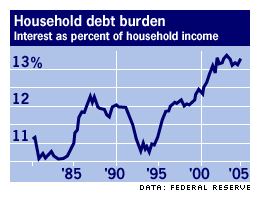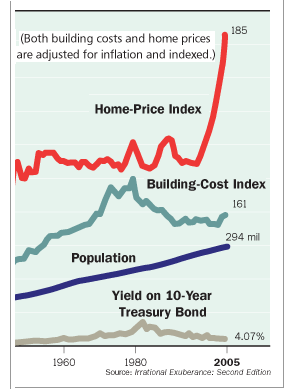

|
| weblog/wEssays | home | |
|
A Sobering Clipping File on Risk (October 6, 2005) Herewith are clippings which relate to recent posts on the unprecedented risks facing the U.S. stock market and economy:  Reuters: "The credit derivatives market grew by almost 48 percent in the first six months of the year to
$12.4 trillion, the International Swaps & Derivatives Association (ISDA) said on Wednesday."
Reuters: "The credit derivatives market grew by almost 48 percent in the first six months of the year to
$12.4 trillion, the International Swaps & Derivatives Association (ISDA) said on Wednesday."
Just in from the Fed: non-mortgage household interest at new highs
Marc Faber: "The Bureau of Labor Statistics has calculated that health care inflation in the last ten years or so averaged about 4% per annum. However, from private studies we know that health care costs have risen by around 10% per annum in the last few years. Moreover, whereas the weighting of the BLS's health care expenditures within the CPI is only 6%, health care represents about 17% of consumption." Richard Daughty: (Mogambo Guru Economic newsletter) As a kind of interesting coincidence to this prediction (a Dow low of 8450 by December 1, 2005) is the appearance of the Hindenburg Signal, which is a signal based upon the number of new stock highs and new lows as a percent of total volume that was developed by Kennedy Gammage. The Hindenburg Signal predicts that a stock market crash has become likely within the next 30 days. Not only that, but the McClellan Oscillator is negative. Somebody, I forget who, noted that the latest University of Michigan Consumer Sentiment also produced a stock market crash signal, in that it had a one-month fall that was the biggest drop in fifteen years or something." 10/5/05 CBS Marketwatch column on the Hindenburg Signal Wall Street Journal, October 5: "Asian Bull Markets Face Twin Red Flags Energy Prices, Rising Rates, Could Curtail the Rallies; Local Investors in the Mix"  "But the gains have come as energy prices have jumped, threatening to spark inflation -- and leading many
observers to question whether the major Asian equity markets are accurately reflecting the underlying health
of the region's economies."
"But the gains have come as energy prices have jumped, threatening to spark inflation -- and leading many
observers to question whether the major Asian equity markets are accurately reflecting the underlying health
of the region's economies."
An unprecedented housing bubble
as housing price index skyrockets Yahoo News: "The Interior Department said Tuesday that heavy damage by Hurricanes Katrina and Rita would mean a slow recovery for offshore natural gas production. The Gulf Coast produces about one-fifth of the product used by U.S. industry and to heat homes. The loss of output is particularly troublesome, analysts say, because there is no emergency stockpile. Natural gas futures, which closed at a record high $14.224 per 1,000 cubic feet on Tuesday, jumped an additional 39.6 cents to $14.62. 'The outlook for winter is grim, and the threat to the U.S. economy is real from extremely high gas prices and shortages,' Energyintel analyst Tom Wallin said in a research note." Is this the snapshot of a healthy economy? I think not. * * * copyright © 2005 Charles Hugh Smith. All rights reserved in all media. I would be honored if you linked this wEssay to your site, or printed a copy for your own use. * * * |
||
| weblog/wEssays | home |